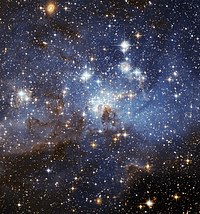
Photo from wikipedia
Context Previous attempts at segmenting molecular line maps of molecular clouds have focused on using position-position-velocity data cubes of a single molecular line to separate the spatial components of the… Click to show full abstract
Context Previous attempts at segmenting molecular line maps of molecular clouds have focused on using position-position-velocity data cubes of a single molecular line to separate the spatial components of the cloud. In contrast, wide field spectral imaging over a large spectral bandwidth in the (sub)mm domain now allows one to combine multiple molecular tracers to understand the different physical and chemical phases that constitute giant molecular clouds (GMCs). Aims We aim at using multiple tracers (sensitive to different physical processes and conditions) to segment a molecular cloud into physically/chemically similar regions (rather than spatially connected components), thus disentangling the different physical/chemical phases present in the cloud. Methods We use a machine learning clustering method, namely the Meanshift algorithm, to cluster pixels with similar molecular emission, ignoring spatial information. Clusters are defined around each maximum of the multidimensional Probability Density Function (PDF) of the line integrated intensities. Simple radiative transfer models were used to interpret the astrophysical information uncovered by the clustering analysis. Results A clustering analysis based only on the J = 1 - 0 lines of three isotopologues of CO proves suffcient to reveal distinct density/column density regimes (nH ~ 100 cm-3, ~ 500 cm-3, and > 1000 cm-3), closely related to the usual definitions of diffuse, translucent and high-column-density regions. Adding two UV-sensitive tracers, the J = 1 - 0 line of HCO+ and the N = 1 - 0 line of CN, allows us to distinguish two clearly distinct chemical regimes, characteristic of UV-illuminated and UV-shielded gas. The UV-illuminated regime shows overbright HCO+ and CN emission, which we relate to a photochemical enrichment effect. We also find a tail of high CN/HCO+ intensity ratio in UV-illuminated regions. Finer distinctions in density classes (nH ~ 7 × 103 cm-3 ~ 4 × 104 cm-3) for the densest regions are also identified, likely related to the higher critical density of the CN and HCO+ (1 - 0) lines. These distinctions are only possible because the high-density regions are spatially resolved. Conclusions Molecules are versatile tracers of GMCs because their line intensities bear the signature of the physics and chemistry at play in the gas. The association of simultaneous multi-line, wide-field mapping and powerful machine learning methods such as the Meanshift clustering algorithm reveals how to decode the complex information available in these molecular tracers.
Journal Title: Astronomy and astrophysics
Year Published: 2018
Link to full text (if available)
Share on Social Media: Sign Up to like & get
recommendations!